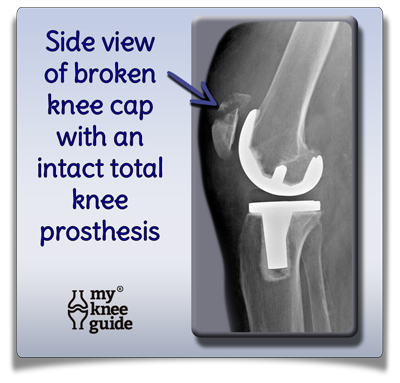
Significant pain following knee replacement surgeryknee replacement surgery is not common. However, approximately 10% of patients who undergo surgery may be dissatisfied with their outcome. Pain and stiffness are frequently cited as the reason for a less than optimal result. Unfortunately, some of these patients will not find a reason for the source of their ongoing symptoms. However, if a patient has these problems then it is important for the surgeon to evaluate for both direct and indirect causes of the pain.
If the post-operative pain is specifically related to the knee then we will refer to this as a direct cause. These direct causes include complications such as infectioninfection, loosening of the knee componentsknee components, adhesionsadhesions, tendon rupture or fracture. The following picture shows an example of a fracture. This x-ray shows the side view of Phyllis's knee replacement after she suffered a fall. Specifically notice on the left side of the image showing the arrow pointing to the knee cap. She broke (fractured) the top portion of her knee cap (patella). Happily, the knee replacement components are still well positioned and she ultimately healed without any residual pain or weakness. Pain after a fall needs to be evaluated by an orthopaedic surgeon.


It's important to keep in mind the typical timeline for recovering from surgerytypical timeline for recovering from surgery, before a patient becomes too concerned about ongoing post-operative pain. However, if there continues to be significant pain six months to one year after surgery this needs to be further evaluated by an orthopaedic surgeonorthopaedic surgeon. The initial work-up for pain will likely include lab studies and x-rays. The labs will focus on evaluating for subtle signs of infection by looking at the white blood cell count and looking at markers for inflammation. X-rays will be used to ensure proper alignment of the prosthesis and to confirm that there are no radiographic indicators of loosening or change of position compared to previous x-rays. A bone scan can be helpful to look for signs of loosening as well. Occasionally, an MRI (using a metal artifact suppression technique – MARS) or CT scan will be ordered; however, these testing modalities are hampered by the presence of the prosthesis.
The physical exam is also very important. During the exam, the surgeon may be able to detect signs of instability of the prosthesisprosthesis or evaluate for significant stiffness as a cause for the pain. Less commonly, the surgeon may discover that there is soft tissue (scar tissue) impingement that is occurring between the components of the knee replacement. Sometimes this can be addressed with an arthroscopy (minimally invasive) of the knee replacement to remove (debride) this tissue.
Some patients may not have had their knee cap replaced during the initial surgery. This is actually quite common in Europe compared to the United States. These patients do have an increased chance of developing pain in the front of the knee. Occasionally, the patient may need to have the knee cap replaced at a later time. Other patients may have difficulty with the replaced knee cap tracking incorrectly on the rest of the prosthesis. This may be treated with a surgery called a "lateral release" to improve the position of the knee cap.
If the patient requires a second surgery to change out the implanted components, it is called a revision surgery. This may happen for some of the reasons previously discussed. Revision surgeries are most successful when the surgeon is able to pre-operatively identify the cause for the pain. Likewise, revision surgery is much less successful in reducing pain if the physical exam and the studies fail to reveal the specific cause for pain. These are complicated situations and need to be discussed with the orthopaedic surgeon. Recently, there has been increased media attention on this situation. Read "Does Your Joint Replacement Have a Warranty?""Does Your Joint Replacement Have a Warranty?" on our blog for an interesting perspective on the current state of knee replacement warranties.
Sometimes the knee can hurt after surgery, but the cause is not actually coming from the knee. Indirect causes of knee pain following knee replacement include hip arthritis, sciatica, knee bursitis or systemic diseases such as fibromyalgia. Pain from hip arthritis usually occurs in the groin, but can also manifest in the thigh or the inside of the knee. Occasionally, the primary complaint from hip arthritis can be knee pain. If a patient's knee pain primarily occurs when the hip is rotating, it is important to have an x-ray of the hip.
Sciatica commonly presents as pain traveling from the buttock down to the knee, the shin, and possibly the foot. Sciatica is frequently (but not always) associated with back pain. Radiating pain through the knee can be caused by a herniated disc in the lower back. Knee bursitis is a common source of post-operative discomfort and occurs just below and to the inside of the incision lineincision line. Bursitis can be treated with a cortisone injectioncortisone injection and/or therapy.














